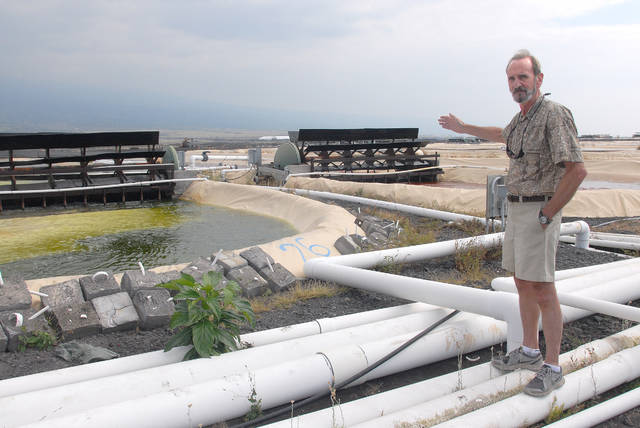KAILUA-KONA — Limited access to fresh water, inclement weather and a volcanic eruption has resulted in growing pains for Cyanotech Corp., forcing the company to post a loss for a third consecutive quarter.
The Natural Energy Laboratory of Hawaii Authority-based company announced this week it lost $1.13 million during the second quarter of fiscal year 2019, which runs July through September. During the same period in FY 2018, Cyanotech was turning a profit of $475,000.
The company, a producer of microalgae-derived products, including the supplement BioAstin, Hawaiian Astaxanthin, and Hawaiian Spirulina Pacifica, has now posted losses for the past three quarters, including the fourth quarter of fiscal 2018 and the first and second quarters of fiscal 2019.
Cyanotech’s last reported profit was $1.1 million in the third quarter of fiscal 2018, or October to December 2017.
Halfway through fiscal 2019, losses have reached $2.4 million, a substantial difference from the same time period in fiscal 2018 when the company reported profits of $977,000. For the fourth quarter of fiscal 2018, January through March, the company posted a $1.05 million loss.
Cyanotech pointed to a host of issues that have plagued the company for months.
The company said it ceased production from April to mid-May after an “unusually cool, cloudy and rainy winter” and a fresh water supply restriction issued by the Hawaii County adversely effected spirulina production. That led to the growth of small and difficult to harvest spirulina.
To correct nutrient levels and stabilize production, the company in early April re-inoculated its spirulina ponds, resulting in no spirulina production during a month-and-a-half re-inoculation process, Gerald R. Cysewski, Ph.D., Cyanotech’s founder and chief scientific officer said in June.
“The re-inoculation we initiated in the first quarter of this fiscal year continued to restrict supply in the second quarter, which in turn significantly reduced our net sales and gross profit margin,” Cyanotech’s Chief Executive Officer Mawae Morton said this week.
However, spirulina production has returned “to mostly normal production levels,” and the company doesn’t expect the re-inoculation to have significant negative impacts on future financial results, Morton added. He noted demand remains high and as of Sept. 30, the company had a “large number” of open orders.
Making matters worse was the eruption of Kilauea Volcano that began in May and resulted in volcanic smog, or vog, over West Hawaii areas. The company said that while vog doesn’t affect product quality, it cuts light to the ponds by about 10 percent.
This week, Cyanotech said the reduced light levels lowered production of astaxanthin, resulting in a 2.8 percentage point decrease in gross profit margin.
Shares of Cyanotech (Nasdaq: CYAN) dropped 12 cents — or 7 percent — on Thursday to $3.32. On Monday, the day the quarterly results were posted, Cyanotech shares opened and closed at $3.50. Shares rose on Tuesday and Wednesday before dropping Thursday.
On Feb. 7, the day after the company reported its last profitable quarter for the months October through December 2017, shares of Cyanotech closed at $5.35.
Meanwhile, the company’s acquisition of the Kona Demonstration Facility, a research and development plant on 6 acres owned by Cellana Inc. within NELHA, remains on track to close by year’s end, according to the publicly traded company’s most recent quarterly filing with the U.S. Securities and Exchange Commission.
While the Cyanotech and Cellana both declined to disclose details or terms of the transaction when the asset purchase agreement was announced Sept. 7, submittals to the state Land Board, stated Cyanotech is paying $495,000 over 12 months for Cellana’s facilities.
Cyanotech said in a Sept. 7 press release that the company expects to use the Kona Demonstration Facility in various ways, including expanding its research and development along with product development and supplementing its production capacity. It currently operates on 90 acres.



